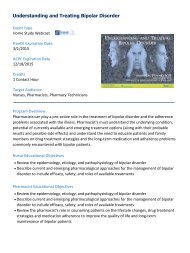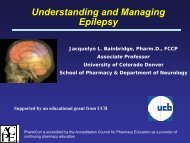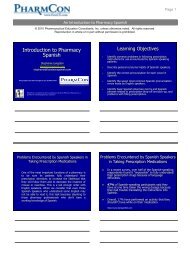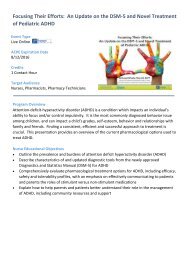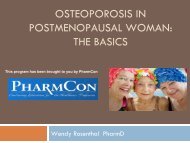Thyroid Monograph - FreeCE
Thyroid Monograph - FreeCE
Thyroid Monograph - FreeCE
You also want an ePaper? Increase the reach of your titles
YUMPU automatically turns print PDFs into web optimized ePapers that Google loves.
The most common cause of hyperthyroidism, accounting for 60 to 80 percent of<br />
cases, is Graves’ disease. 10 This is an autoimmune disease caused by an<br />
antibody that binds to and activates the TSH receptor and stimulates the gland to<br />
synthesize and secrete excess thyroid hormone. Autonomous production of<br />
thyroid hormone occurs when thyrocytes function independently of TSH receptor<br />
activation, which could result from a benign thyroid adenoma or nodules from a<br />
toxic multinodular goiter. Toxic adenomas are common in younger patients and<br />
in iodine-deficient areas. 11 Toxic multinodular goiter (also known as Plummer<br />
disease) accounts for about 15 to 20 percent of hyperthyroidism cases and can<br />
be 10-fold more common in areas where there is iodine deficiency. 11 This also<br />
occurs more commonly among elderly patients with a long-standing goiter. 12<br />
<strong>Thyroid</strong>itis is an inflammatory condition that could cause transient excess<br />
secretion of thyroid hormones. This includes subacute thyroiditis (caused by a<br />
viral infection and may resolve within eight months), lymphocitic thyroiditis,<br />
postpartum thyroiditis (can occur in up to 5 to 10 percent of women 3 to 6 months<br />
following delivery), radiation-induced thyroiditis, and pharmacologic thyroiditis<br />
(precipitated by amiodarone). 13 Iodine-induced hyperthyroidism can sometimes<br />
occur after intake of excess iodine in the diet or exposure to radiographic<br />
contrast media, leading to an increase in the synthesis and release of thyroid<br />
hormone in individuals with iodine deficiency and in older patients with preexisting<br />
multi-nodular goiter. 14 Rarely, hyperthyroidism can be caused by tumors<br />
like metastatic thyroid cancer, an ovarian tumor called struma ovarii that<br />
produces thyroid hormone, and trophoblastic tumors that produce beta human<br />
chorionic gonadotropin (β-hCG) which could weakly activate TSH receptors.<br />
C. Other thyroid problems<br />
<strong>Thyroid</strong> nodules are common and can be seen in as many as 50 percent of all<br />
adults, although this condition is more common in women (6%) than in men<br />
(2%). 4 Most of these nodules are small and benign nodules, and only 5 percent<br />
of the cases represent malignancy.<br />
III. Clinical Features and Diagnosis<br />
Hypothyroidism causes a wide range of clinical presentations, from<br />
asymptomatic to myxedema coma, or multisystem organ failure. These<br />
symptoms can be due to derangements in the metabolic processes or<br />
myxedematous infiltration or accumulation of glucosaminoglycans in the tissue.<br />
In the heart, myxedematous changes can result in heart enlargement, pericardial<br />
effusion, and poor function (ie, decreased contractility, decreased cardiac<br />
output). Decreased thyroid hormones can also lead to increased levels of total<br />
cholesterol and low density lipoprotein (LDL) cholesterol in the bloodstream<br />
because of a change in metabolic clearance. An increase in insulin resistance<br />
may also result. In the gastrointestinal tract, decreased acid secretion,<br />
Torio-<strong>Thyroid</strong> Page 4



